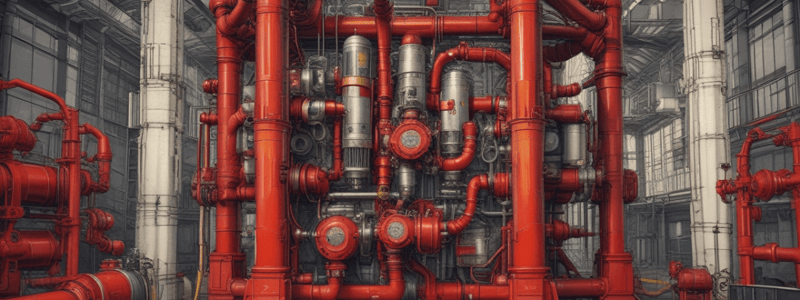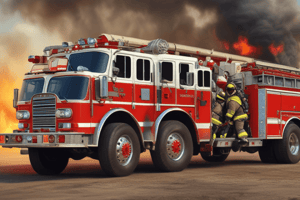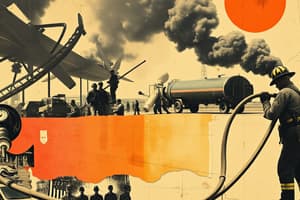Podcast
Questions and Answers
What is the optimal hose arrangement for Third Generation engines with a rear intake?
What is the optimal hose arrangement for Third Generation engines with a rear intake?
- 3” hose to pump suction intake and 3” hose to rear intake
- 3” hose to pump suction intake and 5” hose to rear intake
- 5” hose to pump suction intake and 3” hose to rear intake
- 5” hose to pump suction intake and 5” hose to rear intake (correct)
What is a significant consideration in rural water operations?
What is a significant consideration in rural water operations?
- Increased water pressure
- Reduction of on-scene personnel (correct)
- Decreased water flow
- Increased on-scene personnel
What is the purpose of requesting additional resources in rural water operations?
What is the purpose of requesting additional resources in rural water operations?
- To supplement firefighting operations (correct)
- To disconnect from the attack pumper
- To disconnect from the water tender
- To reduce water pressure
What is the result of tethering multiple apparatus in rural water operations?
What is the result of tethering multiple apparatus in rural water operations?
How many engines are permitted to tether to the attack pumper?
How many engines are permitted to tether to the attack pumper?
What is the purpose of the Booster Back-up method?
What is the purpose of the Booster Back-up method?
What is the preferred connection point for the second pumper to the attack pumper?
What is the preferred connection point for the second pumper to the attack pumper?
What happens to subsequent pumpers shuttling water in the Booster Back-up method?
What happens to subsequent pumpers shuttling water in the Booster Back-up method?
What is the ideal outcome for the attack pumper in the Booster Back-up method?
What is the ideal outcome for the attack pumper in the Booster Back-up method?
What is the purpose of a Water Tender resource in rural water operations?
What is the purpose of a Water Tender resource in rural water operations?
Flashcards are hidden until you start studying
Study Notes
Friction Loss Formula
- FL = CQ2L (formula to calculate friction loss)
- Example: FL = 6.59x1.62x2 = 33.74 psi (calculating friction loss)
- Round to 35 psi for the Friction Loss in the hose (estimated friction loss)
Pump Discharge Pressure Formula
- PDP = NP+FL+APPL+ELEV (formula to calculate pump discharge pressure)
- PDP = 50 psi + 35 psi + 0 psi + 0 psi = 85 psi (example calculation)
St.John's Fire District Pump Chart
- Used to determine friction loss values for handlines and RAM Monitor
- Read as a column-based table, values come from the determined nozzle or GPM column
- Friction loss values are provided for different hose diameters and flow rates
Elevation
- Includes head pressure loss/gain per floor and 0.5 psi head pressure loss/gain per foot
- Counting of floors or feet is from the elevation of the fire pump
- Do not account for the first floor when pumping to a higher floor
High-Rise Operations
- Abridged set of rules for pumping into a FDC for standpipe-equipped buildings
- Position apparatus as close as possible to the connection, preferably within 50’
Pump Chart Defensive Operations
- Provides a single value for apparatus-mounted master stream devices
- Deck Gun and Aerial Waterway utilize an established appliance pressure of 100 psi
- Aerial Waterway adds an elevation value (EVEL) to the appliance pressure
Deck Gun and Aerial Waterway
- Flow rates are predicated on available hydrant flow and nozzle tip diameter
- Example calculations for Deck Gun and Aerial Waterway are provided
Rural Water Supply
- Requires critical thinking to formulate a water supply plan
- Considerations include reduction of on-scene personnel and potential reduction in effective firefighting force
- Effective water supply is dependent on water support and coordinated water shuttle measures
- Booster Back-up method utilizes the second arrival to provide additional water and serve as a reserve water tank
Studying That Suits You
Use AI to generate personalized quizzes and flashcards to suit your learning preferences.



